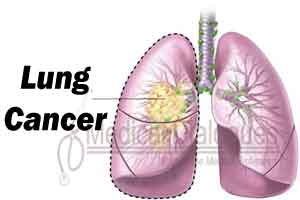- Home
- Editorial
- News
- Practice Guidelines
- Anesthesiology Guidelines
- Cancer Guidelines
- Cardiac Sciences Guidelines
- Critical Care Guidelines
- Dentistry Guidelines
- Dermatology Guidelines
- Diabetes and Endo Guidelines
- Diagnostics Guidelines
- ENT Guidelines
- Featured Practice Guidelines
- Gastroenterology Guidelines
- Geriatrics Guidelines
- Medicine Guidelines
- Nephrology Guidelines
- Neurosciences Guidelines
- Obs and Gynae Guidelines
- Ophthalmology Guidelines
- Orthopaedics Guidelines
- Paediatrics Guidelines
- Psychiatry Guidelines
- Pulmonology Guidelines
- Radiology Guidelines
- Surgery Guidelines
- Urology Guidelines
Prototype drug uses novel mechanism to treat lung cancer

Cells are constantly turning proteins on and off via molecular switches -- phosphate molecules -- that have become common drug targets. Said Dr. Narla, "All the drugs we currently have to treat our cancer patients target what we call kinases, which attach phosphate molecules to proteins. But equally important to this are the enzymes that take the phosphate off."
One enzyme -- PP2A -- can "turn off" tumor proteins by removing phosphate molecules attached to them. But according to Dr. Narla, "This tumor suppressor is turned off in pretty much every major cancer. Its inactivation is essential for a normal cell to become a cancer cell."
Narla and his team decided to take an unconventional approach to cancer drug development by seeking molecules that directly target PP2A, in an effort to reactivate its tumor suppressor properties.
Forty-five researchers, including eight students from the Young Scientist Foundation and Mark R. Chance, PhD, Vice Dean for Research at Case Western Reserve School of Medicine, collaborated to screen a series of drug-like molecules for their ability to reactivate PP2A in lung cancer cells and prevent lung cancer tumors in mice. The prototype drug molecules were created from FDA-approved medications by Michael Ohlmeyer, PhD, Associate Professor at Icahn School of Medicine at Mount Sinai.
The team found one particular prototype drug can attach to a subunit of the PP2A protein, effectively activating the enzyme. As Narla explained, the study is the first to use a small molecule to directly activate an enzyme that removes phosphate molecules. "There are indirect ways that have been shown to get at these kinds of enzymes, but this is the first example of a direct activation of one. Our drug actually binds to and turns on PP2A."
The prototype drug also prevented lung cancer cells from proliferating in laboratory models, including mouse models. Mice injected with the drug had fewer lung cancer tumors and did not experience weight loss or behavioral abnormalities associated with other cancer medications. In the mouse models, the drug was comparably effective to currently available combination therapies used to slow lung cancer progression.
To confirm exactly where the drug attaches to PP2A, the researchers also developed lung cancer cells with specific mutations at the putative drug binding site. Mice with tumors created from the mutated cancer cells did not benefit from the prototype drug, as the drug could not attach to and reactivate PP2A. The results confirmed that the prototype drug attaches to PP2A at two specific amino acids within a subunit of the enzyme, information that could help inform other drug developers.
"This is the first example ever of a cancer drug that directly binds to and activates an enzyme that removes phosphate molecules. Therefore our findings could have broad applicability to the treatment of a large number of human cancers, including lung cancer as we demonstrated in this paper," Narla said.
"There are some 2,000 plus papers on the role of PP2A in cancer. Breast cancer, prostate cancer, lung cancer, brain cancer, childhood cancers, ovarian cancer, endometrial cancer, every major cancer involves the inactivation of this protein," Narla noted. "Molecules that allow us to turn it back on, like the one in our study, have the potential to work in a broad range of cancer patients."
"We are continuing to test our drug in a large series of animal models. If things continue to go well, we hope to start clinical trials next year with this drug. Our initial clinical trials would be quite broad, and would include a number of diverse cancer patients, including patients with lung cancer." Narla said.
"The Young Scientists supported by the Young Scientist Foundation, www.ysf.org, were integral to these discoveries," Narla added. "I think their contributions highlight, in an increasingly competitive funding environment, the importance of STEM and the benefit of engaging youth early on in biomedical research."
Limitations
The study included pre-clinical cell and animal models that may not necessarily translate to human lung cancer. Mice were implanted with lung cancer tumors, rather than developing them on their own, and treated with the drug for only four weeks. Long-term effects of the prototype drug remain unknown.

Disclaimer: This site is primarily intended for healthcare professionals. Any content/information on this website does not replace the advice of medical and/or health professionals and should not be construed as medical/diagnostic advice/endorsement or prescription. Use of this site is subject to our terms of use, privacy policy, advertisement policy. © 2020 Minerva Medical Treatment Pvt Ltd